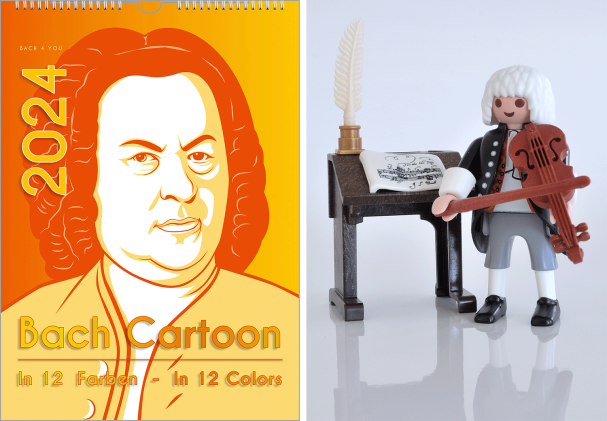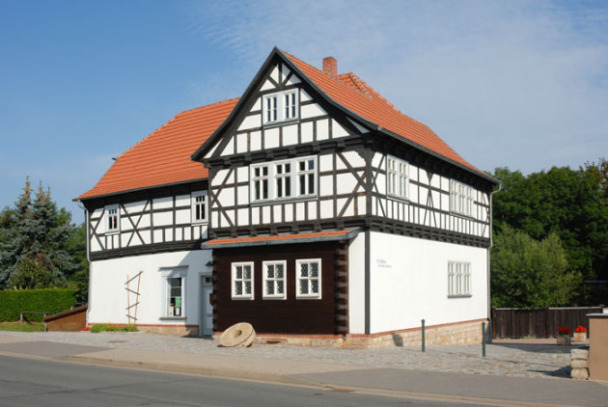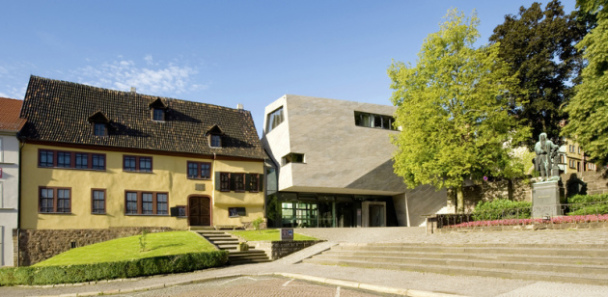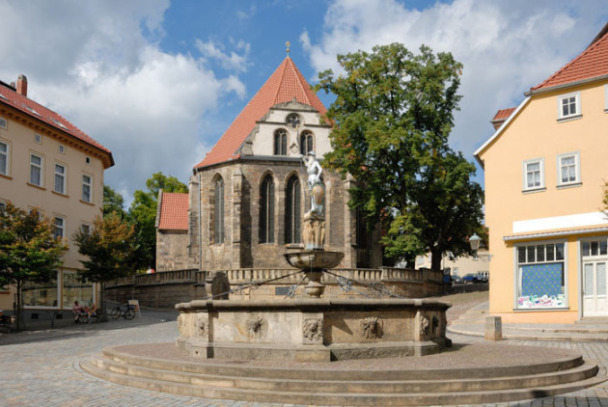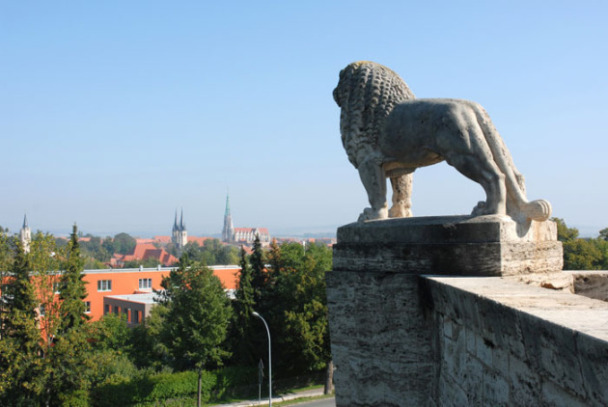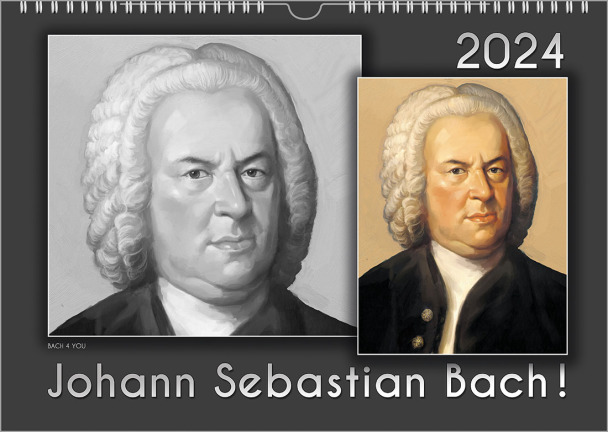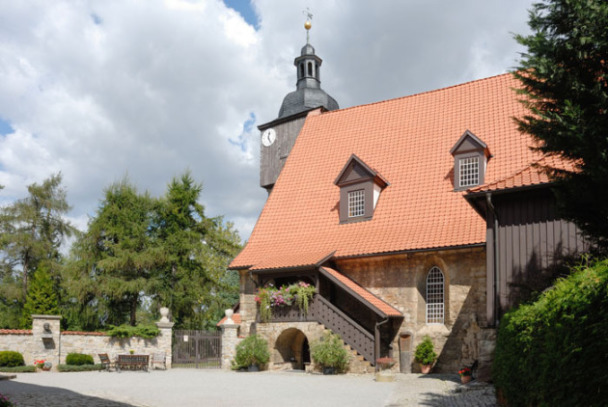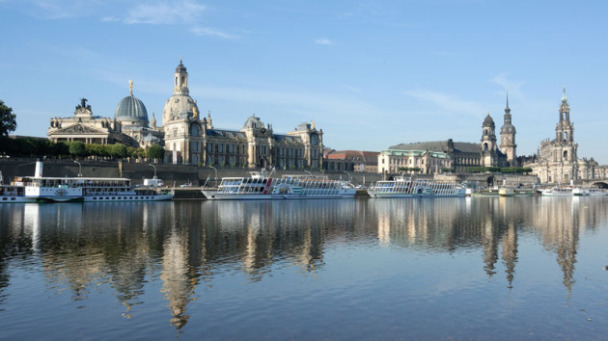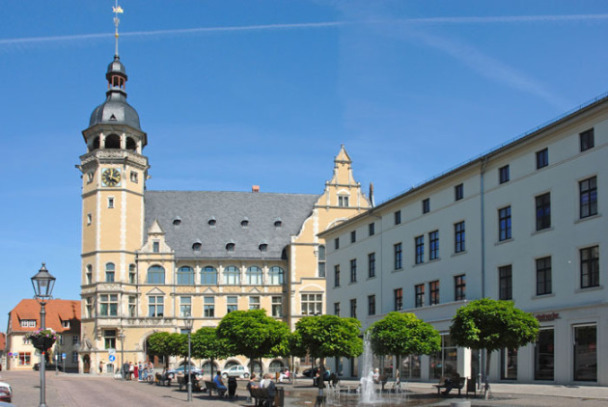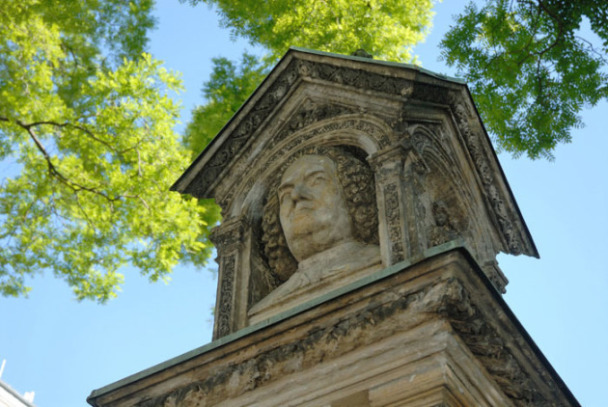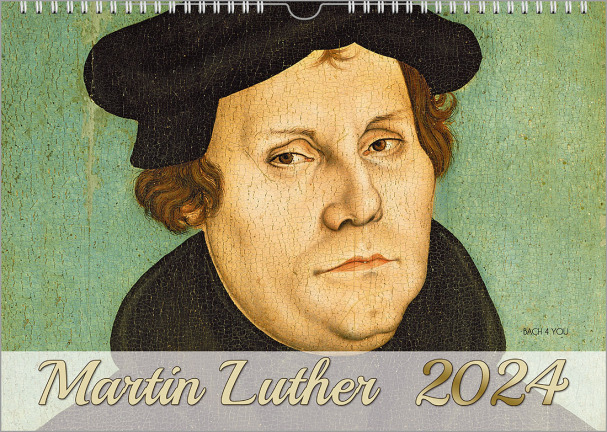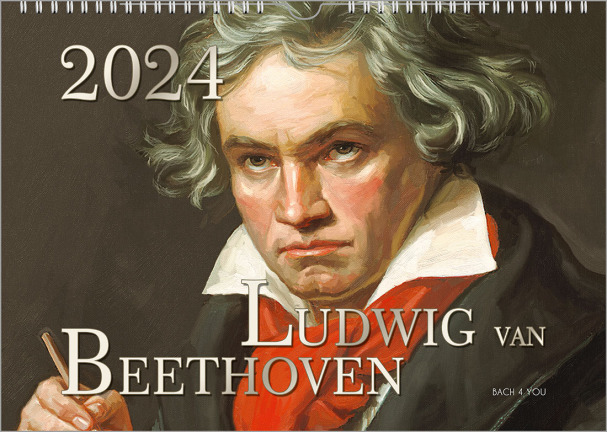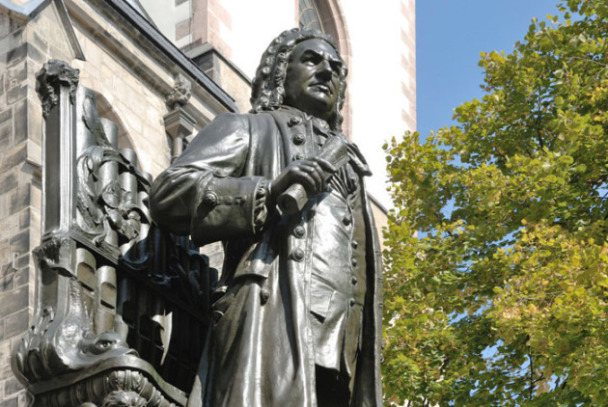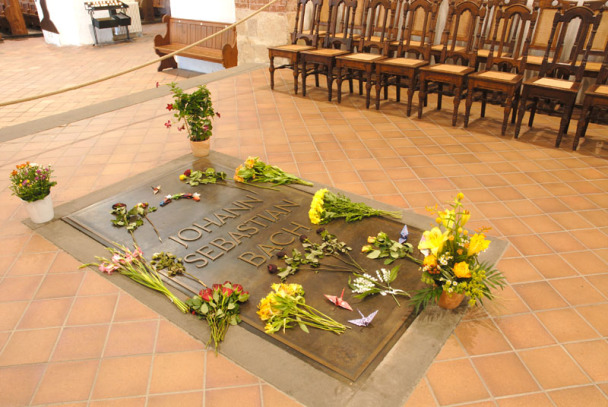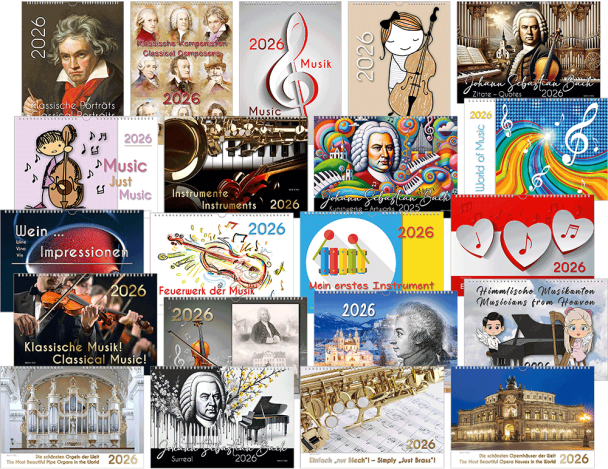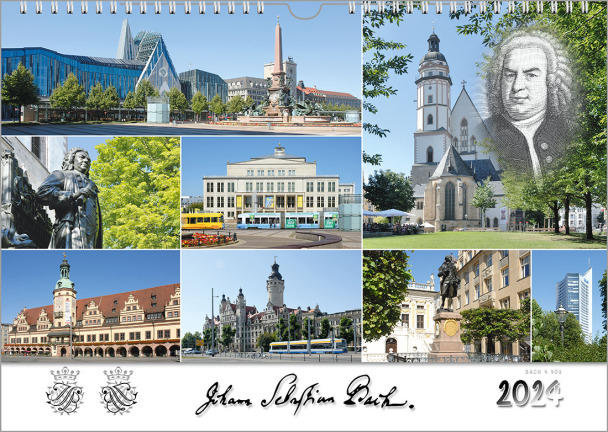
A presentation, an essay, a homework assignment. That's how the pros do it: Firstly, just "get into the subject" in nine minutes. That means: First of all, take a look at my video. With the music of Johann Sebastian Bach and with the places and cities in which he lived. And actually with everything important, from before his birth to after his death: everything to the point. Have fun watching.
Bach, of all things. That is also my name. So the author of this page. And my wife is also called Bach. More precisely? My name is Peter Bach Jr, my wife's first name is Renate. Since 2011 we are enthusiastic about the composer Johann Sebastian Bach and since this year I have compiled a meanwhile enormous Bach portal. During this time, Renate has continued to research the family tree of Johann Sebastian Bach. If your homework, presentation, lecture or essay should not only be pure text, then you will also find some photos on the topic here on this page. On Bach on Bach you will find "tons of motives": pictures, wood engravings, steel engravings, etchings, paintings, drawings and much more. We both, Renate and I, have a huge request: If this, my website, has helped you with your "job", either this website, or, much better, the whole portal Bach on Bach, please inform your teacher – probably it is your music teacher – about my websites. Maybe he or she doesn't know these websites yet, and we wish very much that every music teacher knows that they exist. Thank you very much for this and good luck with your presentation, essay or homework about Johann Sebastian Bach.
Advertisement = Promotion = Commercial
Music Gifts and More Music Gifts, for Instance Music Calendars, Music T-Shirts, and Music Mugs
We sincerely ask for support to help fund our Bach mission ... learn more here.
99 Great Music Calendars, Cool Composers Calendars and Nice Bach Calendars ... Plus ... Pipe Organ Calendars
Bach calendars, composers calendars and music calendars: That's what you get from "Bach 4 You", the small Calendar Publishing House in Southern Germany. There are always three calendar sizes. And they are available 2024 + 2025. To the shop.
End ... of Advertisement ... of Promotion ... of Commercial
First of all, you will not find a ready-made homework or essay here, which you are supposed to write yourself. So the task of creating your presentation remains with you. But I have dealt so much – in the past years – with Johann Sebastian Bach, that I believe to be able to give you quite good tips with your essay, your presentation, your homework or term paper, which you would otherwise have to search and work out laboriously ... and without me. Let's go.
Regarding Introduction, Main Part and End of Your Presentation About the Master Johann Sebastian Bach
Okay, back to your homework, your essay or your presentation about Johann Sebastian Bach. You start with this job best, like every essay with an introduction. Next is the main part, last is the final part. So, why don't you start this presentation not just like a biography? Actually like every biography about Johann Sebastian Bach, that is with his genealogy. The beginning of your presentation with a great quotation about Bach is also really cool. There are about 66 of them. Back to the genealogy, that is, to the ancestors of the later Thomas Cantor. That is, back to the first of the almost infinite number of Bachs, who all earned their money with music. What do you need to think about for your homework? It's best to leave out much, better yet most, of his ancestry. The Bach genealogy is tremendously confusing and complicated. What matters: There are two "start dates" – years when things get going – so to speak. 1504, this date, is mentioned as the first year by a Bach in a historical letter: That's when everything is said to have started. But the Bachs were not yet musicians then.
And then it is also the year 1619. To 1504 there is the name Hans Bach. But one does not know when this Hans was born and also not where. With this year 1504 there is certainly trouble with your teacher. That's how unknown it is. Even the Wikipedia contribution about him is wrong from front to back. Because I researched it only a short time ago. And 1619? 1619 died in Wechmar in Thuringia exactly the Veit Bach, who is documented. This Veit Bach is the great-grandfather of JSB. He is also the first musician in the family. And how do you know that? Because Johann Sebastian Bach himself wrote it down. He compiled 51 musicians in his Origin (... Ursprung) of the Musical Bachish Family. Actually there are 53 persons, but two of them were not musicians. Female musicians in this family, and they did exist, Bach simply left out. So you are right when you start it like this: "It all began with Veit Bach, who died in 1619, and that was in Wechmar in Thuringia. He was the first musician in the Bach family of musicians, and the great-great-grandfather (... twice "great") of Johann Sebastian Bach. His son, Hans the minstrel (... the Spielmann), was the first to earn money with music. The grandson of Hans the minstrel was finally Johann Sebastian's father, Johann Ambrosius Bach". However, also write this in your own words.
So Johann Sebastian mentions Veit Bach as "No. 1" in his compilation of these 53 male Bachs, almost all of whom played music. This compilation is often defined as a family tree. But it is none. In fact, in this Origin of the Musical Bachish Family, which Bach experts also call "Ursprung" for short, the master has simply omitted much that is necessary in a family tree. The most important thing that is missing is in any case the female musicians. What still exists today as an original about these 53 gentlemen is a handwritten copy by his granddaughter, who copied Bach's original. And there is another copy. That was then a "copy of the copy" by Bach's secretary. JSB's original unfortunately no longer exists today. JSB stands – you guessed it – for Johann Sebastian Bach. For your essay, presentation or homework, the origin of the Bache, as they were called at the time, is another "trap". Johann Sebastian wrote himself, the Bachs came from Ungern (... there is no such noun or a place like Ungern. But there is a country which is called Ungarn, which is Hungary). Attention, he writes, they came from Ungern, with an " e ". So not Hungary. But it is correct that they had emigrated from Germany over two generations and then immigrated again. But be careful, better leave that out. My research is too fresh and too "cross-knitted" and a quarrel between you and your teacher is preprogrammed. In fact, the "cradle" of this famous family of musicians was with ninety-nine percent probability in Thuringia and thus near Wechmar. It is true that these Bachs also lived abroad for a while, but they "did not come from Hungary". And certainly not from Preßburg, which today is called Bratislava. In former times, they wrote Preßburg exactly as I did above. Today it is written Pressburg. By the way, the Bach family is the largest and most important musical family in the world and of all times. And that with a huge distance before the musician families Wagner and Liszt and the Kelly Family, as well as the Jacksons/Presleys.
Attention: It is best to leave out the complete story about the origin of the Bachs. Unless you want to start a real fight with your teacher ... and maybe, just maybe, win. And why might there be an argument? Because ninety-nine percent of all Bach fans, Bach biographers and Bach scientists are quite sure that the Bachs come from Hungary after all. Renate and I have found out that there were – according to an essential document – still three generations earlier (... thus before this Veit in Wechmar), which one can assign to the Bach genealogy. And these three generations actually lived in Thuringia, in Czechia and in Austria. If you really want to "dive" quite ... really quite, quite deeply into the actually highly complicated matter of the Bach genealogy, then you are – so to speak – cordially invited. With a click on this link. And with this knowledge you can then also convince your teacher – quite possibly – if he or she also reads up on it there.
In a short essay, I'm sure it's not all that important: In Wechmar, Veit Bach, the great-great-grandfather of Johann Sebastian Bach, was a miller and baker. In the picture above you can see today's Veit Bach Mill in Wechmar in Thuringia. It was demolished "by a hair" for the construction of a new road. And in this mill he probably also played music to the beat of the mill wheel.
The Main Part of Your Homework: What’s the Best Way to Get Started?
How would I do that? Well ... put the name of the person your essay is about first. There you write that Johann Sebastian Bach was one of the most famous musicians in the world and that he lived in the Baroque period. Johann Sebastian Bach was also the "light figure" (... the most famous in this family by far), that is, the best in the largest and most famous family of musicians in the world. Then you add his dates of birth, in fact he was born in 1685 in Eisenach in Thuringia ... and died in 1750 in Leipzig in Saxony. His father, his grandfather, his great-grandfather and his great-great-grandfather were also musicians. Johann Sebastian Bach was the eighth of eight children. He married twice in his life and became the father of 20 children. So ... now you pick out a few key values in this section – or in the sections above – formulate three or four sentences ... and your introduction is ready.
The Timeline in the Main Part of Your Homework: Bach’s Childhood and Youth ... Eisenach, Ohrdruf and Lüneburg
The main part in your homework, paper or essay about Johann Sebastian Bach: It continues, of course, with Bach's childhood and youth. Then follows the working life of the master as a musician. It is important for you to know in advance that exciting things about the musician are not evenly distributed over his lifetime. If you want your paper or your essay to be exciting, it makes sense to divide the life of Johann Sebastian Bach into three parts. First he was a child and then a pupil: for about 18 years. Then followed "everything" before his time in Leipzig, then finally his time in Leipzig. He was in Leipzig for 27 years, the last 27 years. Johann Sebastian Bach was born in 1685 in Eisenach, he died in 1750 in Leipzig (... we already had that above). You can make your presentation or essay exciting if you can include that Bach was born and grew up in Eisenach, but was not born in the Bachhaus (... Bach House). But that was thought to be the case for over 100 years. At the age of nine and almost ten, Johann Sebastian Bach lost first his mother, then his uncle, and finally his father.
What is exciting about the time in Eisenach is that Johann Sebastian already accompanied his father to make music with him. By the way, half of his siblings did not grow up, but died earlier. By the way: Here you will learn relatively little about the life of Johann Sebastian Bach for your essay, homework or presentation, but mainly how to "build" an essay or homework about the musician, so the framework ... so to speak. But my FAQ is then the next and a perfect step to make your essay, homework or presentation high quality.
In the main part of my page on the topic "presentation, homework or essay" here is now the city number 1 in the life of Johann Sebastian Bach: It is Eisenach in Thuringia. Above you can see the yellow Bach House on the left. But he was not born there, it was about one-minute walk away. In fact, that was there where ... the Bachs lived in 1685. To the right of it at the top is the ultra-modern Bach Museum and – again – to the right of it, relatively tiny, you can see the Bach Monument.
Homework JSB, next part: Ohrdruf. Here, Johann Sebastian Bach lived with his eldest brother after the death of his parents. He went there after no one in Eisenach could earn money with music anymore. Johann Sebastian had a second brother, who was also older. With him and his older sister, he lived in Eisenach until the death of his father and mother. And with his older brother, he then moved in with this oldest brother in Ohrdruf. So finally there lived three Bach brothers. The oldest of the three, however, was no longer a child. He was already married, had a child of his own and of course ... also a profession. The "highlight" of the time in Ohrdruf is the story with the music book with works of famous composers of that time, which Johann Sebastian wanted to copy at all costs. The adult brother, however, did not allow him to do so-and-so little Johann Sebastian "fished" it out of a cupboard with bars, copied it and was caught by his brother while he was practicing to play what he had copied. The oldest brother not only took the copy away from him, but Johann Sebastian never got it back. Incidentally, Bach also met his friend Georg Erdmann in Ohrdruf.
Next section in your homework, essay or project: the time in Lüneburg. There, Bach and his friend Erdmann walked ( ! ). At that time, it was an incredibly long distance, a whole 300 kilometers (... some 200 miles). A carriage ride would have taken very probably even longer, because carriages very often broke down and if something like that happened, then the stay, until it went on, was quite long. This happened, for example, when a wheel had to be repaired. Stagecoaches also often simply got stuck on muddy roads. And it cost a lot of money to travel like that back then. Nothing special happened in Lüneburg. Bach continued to go to school there. But that is relatively unimportant, depending on how long you want your presentation to be. He already sang there and earned his first money. However, he was not allowed to keep all of it. A tip: On my website Bach on Bach there are five short biographies of different length and also facts. There's a profile and yes also the FAQ. First plan how long you want your work to be. Then decide which short biography you want. To read it, not to copy it! The longer, of course, the more detailed everything is. But please again: Take it only as a basis, "copy and paste" is uncool.
Next step in your essay, homework or project: Bach's school years, in summary. Bach was a moderate student in Eisenach because he was probably often absent because he played music with his father at events. Earning money was more important than schooling at that time. In Ohrdruf, however, he did very well in school because his brother took care of his education. And in Lüneburg he also graduated with success. He could have studied at a university afterwards. But he did not want to. Also, to Thuringia he walked ( ! ) back again. This was the end of Johann Sebastian Bach's school years.
For Your Essay, Remember: There Are Three Locations When Johann Sebastian Bach Was Young ... He Worked In Five
The first half-year after his time in Lüneburg Johann Sebastian Bach probably spent in Thuringia, however they are not sure about that fact. After that half-year, he was offered a job at the court of Duke Wilhelm Ernst in Weimar. As a musician. However, he found that exciting for just a half year. Caution, so he was employed in Weimar twice: in the very beginning of his career, plus later again.
The next place in Johann Sebastian's life and in your essay, homework or project: Arnstadt, Thuringia. There he was "really" employed for the first time. As an organist. Please get the time periods from the FAQ or the facts area. Arnstadt is exciting for you because there are three outstanding stories for every essay or presentation about Johann Sebastian Bach during this period. As an organist, he also practiced with the church choir. One student was particularly disruptive. Bach got annoyed and finally called him "Zippelfagottist". Attention, no " f ", but "Zippel", twice " p " (... it's only of importance in German). Geyersbach was the name of this choir student, and he wanted to give Bach a beating with his buddies, armed with clubs. They ambushed Bach: Bach came back one night from playing music at the nearby prince's court, so he was wearing his court costume, which included an épée. Bach now drew this épée in view of the superior number. But there was no fight: the boys pounced. However, a complaint about this Geyersbach afterwards at the city council had no success, because Geyersbach had respectable parents in Arnstadt.
The second story: Bach applied for a four-week vacation and hiked to Lübeck to learn from a famous musician ... and he also hiked back later, spending a total of twelve weeks on the road. By the way, that was a total of 760 kilometers (...470 miles), round trip. Although he had previously arranged for a substitute (... also a Bach from this family), they were pissed off in Arnstadt. Nevertheless, Bach got only a warning. Please read details in my FAQ. Or in the short biographies.
The third story: Bach had a woman perform, that is, sing, in church. However, women were not allowed to perform artistically in a church at that time. They were allowed to sing along with the others, of course. This is the story of the "strange damsel", at that time this was the name of an unmarried woman. Three events ... and three times there was trouble between Bach and the city council. Again, as mentioned: Details can be found in my FAQ on Bach on Bach. The young musician was now fed up with Arnstadt. In fact, he felt he was not in the wrong and because he was offered exactly the same job in Mühlhausen in Thuringia, he went there. And there he even earned more money. More money than the organist before him ... and more money than in Arnstadt.
In case you want to assemble your essay, presentation or homework as a PowerPoint presentation: This above is the Bach Church in Arnstadt today. When Johann Sebastian Bach was organist at this church back then, it was called the "New Church".
It was in Mühlhausen, Thuringia that Bach composed his first piece of music, the so-called Ratswechselkantate (... Change of the City Council Cantata), entitled "Gott ist mein König" (God is my King), which is very well known today. A total of 1,128 musical works by this master are still in existence today. But be careful with your wording in your homework, essay or presentation. Bach composed "tons more". The most famous Bach researcher even assumes that there were more than 11,000 pieces. But the others have all been lost. There was a fire in Mühlhausen at the time of the signing of the contract. And it was a serious one. 400 houses including stables were gone. This led to a huge inflation: Everything became more and more expensive. And because, especially in Mühlhausen, the church superiors were also "fighting," Bach decided to take on another job. After only one year there. On this occasion it should be mentioned that there is another " landmine" in the history of Bach: in fact, whether Bach's music is only church music or also secular music. The answer: both. 100 percent sure. For example, during the time in Weimar, that is, during the long second period there, in fact for a whole nine years, and also during the time in Köthen, he was not employed in church service at all. So, please phrase that very carefully. Or better yet, just leave it out.
Important in your project, homework or essay: Johann Sebastian Bach worked in five cities. The one above is Mühlhausen, also in Thuringia.
Bach's wedding took place during the Mühlhausen period. He had earlier met Maria Barbara either at one of the annual Bach family reunions, which took place in a different town each year. Or in his Arnstadt time, when Maria Barbara Bach and her sister moved to Arnstadt after the death of their father, organist and composer Johann Michael Bach in Gehren. By the way, Maria Barbara Bach was certainly not the "foreign damsel" whom Bach allowed to sing in the church. She was well known in Arnstadt. Johann Sebastian Bach married his cousin – and more precisely and importantly, his second cousin – in Dornheim, a stone's throw from Arnstadt. In the cute, tiny church there. They were both married by a priest with whom Johann Sebastian Bach was friends. What else was there? Oh yes, there is no picture of Maria Barbara. None, even better, none at all. All pictures on the internet of her are pure fake.
Advertisement = Promotion = Commercial
99 Music Calendars, Composers Calendars, and Bach Calendars
One Bach calendar? No, 33 Bach calendars! Three sizes. EU + US style. 2024 + 2025. To the shop.
We would appreciate your support of our Bach Mission ... learn more here.
End ... of Advertisement ... of Promotion ... of Commercial
For your essay, homework or presentation only four other cities and communities – besides the "real, proper" places of residence –in the life of Johann Sebastian Bach play a minor role: These are 1) Lübeck ... that was this overlong vacation, when he visited a musician there. Then, 2) Dornheim ... that's where Bach got married. 3) Dresden ... there was this famous music competition and, finally, 4) Potsdam ... Potsdam was where the musical highlight of Johann Sebastian Bach's life took place, when he made music for the King of Prussia, Frederick the Great. More info on points 3 and 4 later. But beware: these four cities and locations are really only the unimportant ( ! ) Bach cities and Bach locations.
After just one year, Johann Sebastian Bach moved on again. Away from Mühlhausen. Once again ( ! ) to Weimar. For your essay, your homework or your presentation, the Weimar period is not particularly useful. Nevertheless, you must not forget it, it was nine years. Bach's first children were born in Weimar, and a huge part of his musical works was created here, but "a really cool story" ... Weimar isn't really good for that. Wait, there is one exception: Bach's "exit." In fact, at the end of his time there, he was passed over for promotion, grumbled about it, complained in writing to his prince, got no answer, and grumbled about it even more. The duke had him imprisoned for four weeks to cool him down. For "stubbornness". The problem: At that time, you belonged to your prince, and he had to agree if you wanted to move.
Four Weeks Earlier in Dresden: One of the Most Memorable Competitions in the History of Music Remains in Memory
You absolutely have to "stuff" a nice story into your presentation, homework, or essay. Stuff it in? Yes, because it happened in Bach's time in Weimar, but it was just not another workplace of Bach. Every biographer, including me, had to figure out how and where best to squeeze in this episode. Now you have to do that, too. The famous French musician Louis Marchand played in Versailles, in France. For the French king. Marchand quarreled with his wife, wanted to separate from her and then, of course, not give her any more money from his income. The king in Versailles thought this was stupid, ordered Marchand to do so, and he played only half a concert and then "escaped". For details of what exactly happened, please read my short biographies. Marchand fled to Dresden. There they had the idea that Bach and Marchand could compete musically against each other. Both thought it was a good idea. Bach practiced ... even in Dresden. Marchand, however, thought he was good enough and didn't need to practice anymore. Then Marchand – at the venue in Dresden – sneaked to Bach's parlor at night, secretly listened to his playing in the "manner of the Well-Tempered Clavier", realized that he would probably lose and left Dresden quickly and also at night. Clearly ... Bach had won with that. And he was celebrated by the people of Dresden after his concert.
You can mention the competition in Dresden in your essay or your presentation, but you don't have to. Because the competition with the French musician Marchand was not important. Above, you can see the so-called skyline of Dresden. By the way, Dresden in Saxony is definitely worth a visit.
The Well Tempered Piano ... Actually ... What Is That?
For your essay, homework or presentation, you can now take a little trip into the music of Johann Sebastian Bach. And you will experience a little "aha effect" here and now. It's about the "Well-Tempered Clavier", not so easy to research and understand without help: If you tune a piano perfectly for one key, then a few notes sound completely wrong in another key. You can hear that clearly. And vice versa. But if you tune it only 98 percent perfectly, then no one hears the missing two percent quality. But exactly these two percent are responsible for the discord in the other key. Just something like that! To the point: It is what later on, and still today, is called the "golden middle". That is, not to strive for absolute perfection in one discipline, but to keep the big picture in mind. Who invented it ... Bach invented it, this time not the Swiss.
Köthen Was Bach's Favorite Location
After Bach was released from Weimar prison - next chapter in your homework, paper, essay, whatever - he and his family moved to Prince Leopold of Köthen in Köthen. Köthen, then, was Bach's first place of employment outside of Thuringia. Both Bach and the Prince became friends, and Köthen has been the one place in Bach's life where he would have liked to stay his whole future. He felt comfortable here, with his profession and otherwise. But after a trip, with his prince to Karlovy Vary in the Czech Republic, he came back and his Maria Barbara had died at the age of only 35 and was already buried.
Probably out of love and not to run the household, Bach married a singer at Prince Leopold's court, Anna Magdalena, after no less than 18 long months of mourning. With her, he gradually had another 13 children. Together with the seven, in fact with his first wife, this makes exactly 20. However, half of these 20 kids died earlier than they could grow up. So everything changed in Bach's life from that memorable day of his return, and he eventually moved to Leipzig for various reasons.
Only if it fits the length of your presentation, homework or essay: In Köthen (... in the picture above) everything was perfect for Johann Sebastian Bach at first: Prince Leopold became his friend and also made music himself. The orchestra at this mini-princely court was full of music professionals. And Bach was even allowed to buy musical instruments in faraway Berlin. The city of Köthen was neither too huge nor too tiny for him. But unfortunately everything turned out differently.
27 Years Minus 4 Years: Johann Sebastian Bach Suffers 23 Years Under His Supervisors in Leipzig
Leipzig was "one drama" for Bach ... with a break of only four years in a whole 27 years. In Leipzig, he became the Thomas Cantor. For only four years, however, the rector of the Thomasschule (Thomas School), Johann Matthias Gesner, recognized Bach's quality and promoted him. The remaining 23 years were absolutely no fun for Bach ... with another rector as his superior. A letter in which Bach dejectedly asks his school friend Erdmann if he knew where else Bach could work is, by the way, the only private letter from Bach that still exists today. Read it with a click here. For a presentation, a homework or an essay, the time of Johann Sebastian Bach in Leipzig is also of little use, compared to the many years he lived and worked there. Only three episodes are exciting enough to be told. In addition, there are three episodes in Bach's time there that happened only in passing, but could belong to a short biography. The three episodes in Leipzig: First of all, there is the letter to his school friend Georg Erdmann. We just had that. Then, second, the so-called "Prefect Controversy" with the final tribute to the king in Dresden, when he was appointed Royal Polish and Electoral Saxon Court Composer. And finally, thirdly, there was Bach's trip to the Prussian King in Potsdam and his performance there. Finally, Bach's blindness at the very end of his life is the fourth important sequence, Bach's death is a fifth, and the period shortly thereafter is a sixth.
Nowhere in the world are two Bach monuments closer together than in Leipzig. This above is the Old Bach Monument. It is only about a 17 second ( ! ) walk from the most famous Bach monument on earth. Both are right next to St. Thomas Church. If your presentation, homework or essay is going to be pure text and text only, then this picture here is of no use to you at all. For a PowerPoint presentation, however, this photo is just one of many more I can offer you. Clicking here will take you to these images.
Erdmann Letter, Fight of the Prefects, Musical Sacrifice
About the so-called "Erdmann letter", the "prefect dispute" and the journey to Potsdam to King Frederick II and the subsequent composition of the work "Musical Offering" you can best read in the FAQ. Or better yet, in one of my longer short biographies. To explain that here now would be much too long, and I don't want to do your essay, your homework or your presentation for you.
Advertisement = Commercial = Promotion
Is There Such Or a Similar Luther Calendar Anywhere on the Whole Planet?
Actually it is the youngest of many, many music calendars in the Publishing House "Bach 4 You". Three sizes. US + EU style. 2024 + 2025 ... and learn more here.
Also, this only Beethoven calendar came into being only as a "latecomer" in the Publisher's offer. In contrast to the content of the 33 composers calendars, this Beethoven calendar contains exclusively motifs on the subject of Beethoven. Twelve different masters are portrayed in the 33 composers calendars. Your way to the shop.
End ... of Advertisement ... of Promotion ... of Commercial
Blind, Then Dead, and Forgotten for 80 Years
What remains is that Bach very likely developed diabetes or suffered a first stroke. Or both happened. For both could have caused his blindness. He had a surgery performed in Leipzig by a traveling, famous doctor from London. The first surgery didn't work, nor did the second.
Bach was "actually not ill", except blind. But the medicine of the time (... certainly also the "bloodletting" common at that time) and the effort of the surgeries were responsible for Bach getting worse and worse for the following six months. A final "highlight" worth telling is that after about six months he was suddenly able to see again one day. But on that very day he suffered either his first or just his second stroke, and ten days later Johann Sebastian Bach died.
The most impressing of all Bach monuments. The New Bach Monument in Leipzig/Lipsia. It's a pity you can't show it in an essay or a homework. Or can you?
Buried Hastily, Buried, Worshiped: Your Final Part
Interesting for the end, just for the final part of your presentation, your homework or your essay: At first, Bach was simply dug ... they buried him hastily. No gravestone, no celebration, just "put him in the ground". Then, many years later, they needed the space on the church wall where Bach was buried. And that was for an extension. So they dug Bach up again. At the second funeral, he was buried in a much more solemn manner. Even later, however, the genius of this composer was not really recognized until Bach was finally given a place of super honor near the altar in the St. Thomas Church in Leipzig. Thousands of Bach admirers from all over the world now make a pilgrimage there every year.
You can close the circle for your homework, your presentation or your essay with the "story" that he also gave birth to five musical sons with his two wives. Four of them were even famous. And two of these four were in their time ( ! ) even more famous than their father. More precisely: than their father in his time. Attention: You have to formulate the next info very carefully. Why? Bach's music had become unfashionable shortly after his death, and people didn't want to hear it anymore. People wanted to hear a new style of music. At that time. Around 1750 ... approximately. The music of the four well-known Bach sons, however, was at that time, that is after 1750, contemporary, modern, in demand. And if you asked someone during the lifetime of the sons ( ! ), then these sons of course knew many more people "than the old Bach" and therefore two sons of Johann Sebastian – during their lifetime – were better known and two even more famous than the father, who had died in the meantime. Then, of course, at some point these sons also died and their music, too, was finally no longer contemporary, ... no longer in demand. So one forgot also these works of the four sons: Parity among the five exciting Bach musicians. For 80 years, "no one" was interested in the music of Johann Sebastian Bach. And because no one was interested in it, that's why Bach's complete musical works were considered "lost". Watch out again: It wasn't really gone, that is, the surviving pieces, they were just forgotten. By the general population. They weren't hidden or buried or even disappeared in an attic somewhere. Musicians always knew that Bach's work still existed. Well ... only what we know today of Johann Sebastian Bach was never lost. But many more pieces that Bach composed are no longer preserved today. So: Watch out, black ice, black ice!
It was only exactly 80 years after Bach's death that a musician, himself a famous composer, by the name of Felix Mendelssohn Bartholdy, became enthusiastic about Bach's musical works. He shortened the four-hour-long St. Matthew Passion by half an hour and performed it. The audience was thrilled. And that was the start of "Bach's triumphal procession" around the world. Among Bach fans, it is called the "Bach Renaissance". 101 years after the first performance of the St. Matthew Passion, Mendelssohn Bartholdy performed this very piece for the second time, and it was a triumph. Much later, Bach's works eventually became popular in the United States and eventually around the world. Today, enthusiasm for Classical Music in general is even a booming phenomenon in Asia, especially in Japan and China. Unfortunately, less so in the so-called Western world.
The grave of Johann Sebastian Bach in the St. Thomas Church in Leipzig. In a third attempt, finally, he received his place of honor.
In the Mood for Something Special?
You weren't hoping to find a finished essay, presentation, or homework assignment here?! No? Good. Look up Bach on Bach and if you want to do your job as a PowerPoint presentation, you'll find hundreds of photos, images, documents and suggestions on my website that you can and may download for that purpose. Send me your finished PowerPoint result! With Bach's music to my ears, of course. My wife and I would be very happy and if the work is really cool, there will be a section on Johann Sebastian Bach for Children very soon, where I will present the best works of students and kids about Johann Sebastian Bach worldwide. So, here we go!
Enough of a presentation, homework or essay? Then you can listen to some of the most exciting works by Johann Sebastian Bach in just five minutes. There's really no faster way to "try out" Bach's music. But please don't take it too seriously. Thank you.
Advertisement = Promotion = Commercial
Many Music Calendars in Two Very Different Styles
1,000+ music gifts, 99 music calendars … learn more here.
99 Music Calendars: Pipe Organ Calendars, Composers Calendars, Bach Calendars ... And One Mozart Calendar Plus One Beethoven Calendar
The "Bach cities and Bach places and Bach portraits Bach calendar": three sizes, European style + US style, 2024 + 2025. To the Shop.
End ... of Commercial ... of Advertisement ... of Promotion


